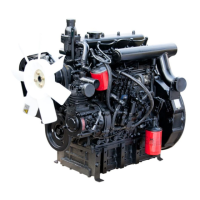MAINTENANCE MANUAL OF ENGINE
126
Working principle of the three-phase alterna-
tor
1. Power generation principle
Electromagnetic induction phenomenon:
A voltage is produced in case of relative motion
between the conductor and field. The voltage
strength of the conductor depends on the magnetic
field intensity, speed of cutting the magnetic field
by the conductor, and number of conductors pass-
ing through the field.
Structural characteristics of the alternator:
The live coil is wound onto the rotating core to
produce a rotating magnetic field, and the
three-phase winding cuts the magnetic line to
produce a three-phase alternating current.
Basic principle of the three-phase alternator:
When the magnet with field winding rotates, the
magnetic flux passing through the cores varies, so
an electromotive force is produced in the
three-phase winding; however, due to existence of
time difference in magnetic flux variation between
the windings at individual phases, the electromo-
tive forces produced also exhibits a time differ-
ence, so as to obtain a three-phase alternating
current.
2. Rectification principle
In the three-phase winding of the stator for the
alternator, the magnetic induction produces an
alternating current. The alternating current is
converted into a direct current by the three-phase
rectifier bridge rectifier circuit formed by six di-
odes (by use of unilateral conductivity of the di-
ode).
The diode shows unilateral conductivity. When a
forward voltage is applied to the diode, the diode
breaks over, and when a reverse voltage is applied
to the diode, the diode is cut off. The diode breaks
over by following principle:
When the negative ends of three diodes are con-
nected, the diode with maximum potential at the
positive end breaks over;
When the positive ends of three diodes are con-
nected, the diode with minimum potential at the
negative end breaks over;
For the three positive tubes (d1, d3 and d5 are
connected with the beginning end of the stator
winding), the positive tube at the phase with
maximum voltage breaks over at certain instant.
For the three negative tubes (d2, d4 and d6 are
connected with the beginning end of the stator
winding), the negative tube at the phase with
minimum voltage breaks over at certain instant,
but there are two closed tubes at the same time, of
which one is a positive tube, the other one is neg-
ative tube.
The diodes in the three-phase bridge rectifier cir-
cuit breaks over in sequence and in a cyclic man-
ner, so that a stable pulsating direct current volt-
age is obtained at both ends of the load "rl". The
average DC voltage output by the alternator is as
follows: u=1.35ul=2.34u&U</P<p></P<p>.
3. Voltage to neutral
Concept of voltage to neutral
When the stator winding is connected by star
connection scheme, the common junction point of
the three-phase winding is called a neutral point,
and a conductor is led from the neutral point of
the three-phase winding to the outside of the al-
ternator, and marked as "n".
The voltage "un" between the neutral point to the
alternator housing (ground) is called the voltage to
neutral, which is a DC voltage obtained through
rectification by three negative diodes (namely
three-phase semi-wave rectification).
The voltage to neutral is half of the output voltage
of the alternator.
Usage of the voltage to neutral
a. The voltage to neutral is usually used to control
relays for applications (such as field relay, charg-
ing indicator relay and etc.);
b. Increase the power output (The eight-diode al-
ternator improves the alternator power output by
use of the voltage to neutral).
4. Excitation method of the alternator
Except that the permanent-magnet alternator does
not require excitation, other alternators require
excitation because their magnetic fields are elec-
tromagnetic fields. that's to say, the field is pro-
duced only when the field winding is energized.
The process in which the electricity is delivered to
the field winding to form a magnetic field is
called excitation. The alternator can be excited by
means of separate excitation and self-excitation.
Separate excitation
Due to weak remanence of the alternator rotor, the
alternator can be self-excited only when it rotates
at higher speed.
During startup of the engine, the battery should
deliver field current to the alternator to produce
magnet, so as to improve the field intensity and
enable the alternator to generate electricity. This
kind of excitation means by which the battery de-
livers current to the field is called separate excita-

